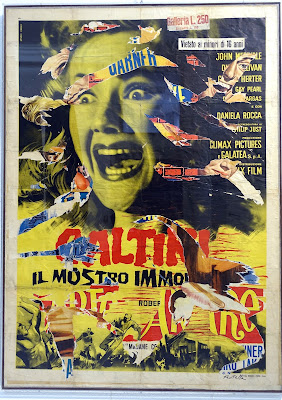 |
| One is greeted on the ground floor by Michelangelo Pistoletto's "L'Etrusco" (The Etruscan), 1976, with Pistoletto's classic use of mirrors, inviting one to join the Etruscan, we we did. |
 |
| "La paura" (Fear), 2004 by Mimmo Rotella. How could we--film reviewers, and one of us an author of an article on Zombie films and the Holocaust--not like this one? |
That's not the Palazzo Farnese, where the French Embassy resides, nor the Villa Farnesina, in the heart of Trastevere where Raphael painted rooms. The Farnesina is the enormous structure designed to be the headquarters of the Fascist party, across the Tevere (therefore, literally Trastevere) but up river adjacent to the Foro Italico, once the Foro Mussolini, the sports complex housing the city's soccer stadium, once its Olympic stadium.
Back to art. Beginning in 2001, the government convinced artists to loan their works to the Ministero degi Affari Esteri (Ministry of Foreign Affairs, equivalent to the U.S.'s state department). It apparently purchased some works, but most are on long-term loan, now comprising the Collezione Farnesina, and open from time to time (hey, it's Rome!).
 |
| "Battesimi Umanoi" (Human Baptisms) by Oliviero Rainaldi, 2006, cement. |
The "di quando in quando" openings began just last year to include the last Friday of every month, except July and August, along with an early May weekend opening for Open House Roma, which is when we went. I'd say run, don't walk, to make your appointment for one of these visits.
The work is also available on Google, but if you think you might go, save your first-time experience for the real thing.
Links are at the end of this post.
The collection is astoundingly rich and unabashedly contemporary. The works fill the walls and halls of this building, whose construction began in 1937. The building itself is filled with artwork from the period of its construction and decoration, which occurred mainly in the post-World War II period, with artists such as Sciajola.
 |
| From Elena Bellantoni's "The struggle for power, the fox and the wolf," 2014 video. This video was filmed in The Farnesina itself. |
 |
| The large meeting room where Bellantoni's video was filmed. |
 |
| Mosaics by Sciajola and ceiling art, part of the building decor. |
 |
| Grand stairway, with original designs on sconces; classic Fascist use of travertine marble, and use of Roman designs, including the painting at the end, with a modernist take. |
 |
| Del Debbio's "first solution" to the "Casa Littoria a Foro Mussolini." The building sits at the base of Monte Mario. |
For visits, consult the Web site (it says it's in English, but it is not: http://www.collezionefarnesina.esteri.it/collezionefarnesina/it/visita/
Google's "virtual tour" is here: http://www.collezionefarnesina.esteri.it/collezionefarnesina/it/visita/google-art-visita-virtuale
Dianne
 |
| Mario Sironi's Il lavoratore ("The worker"), 1936. |


No comments:
Post a Comment